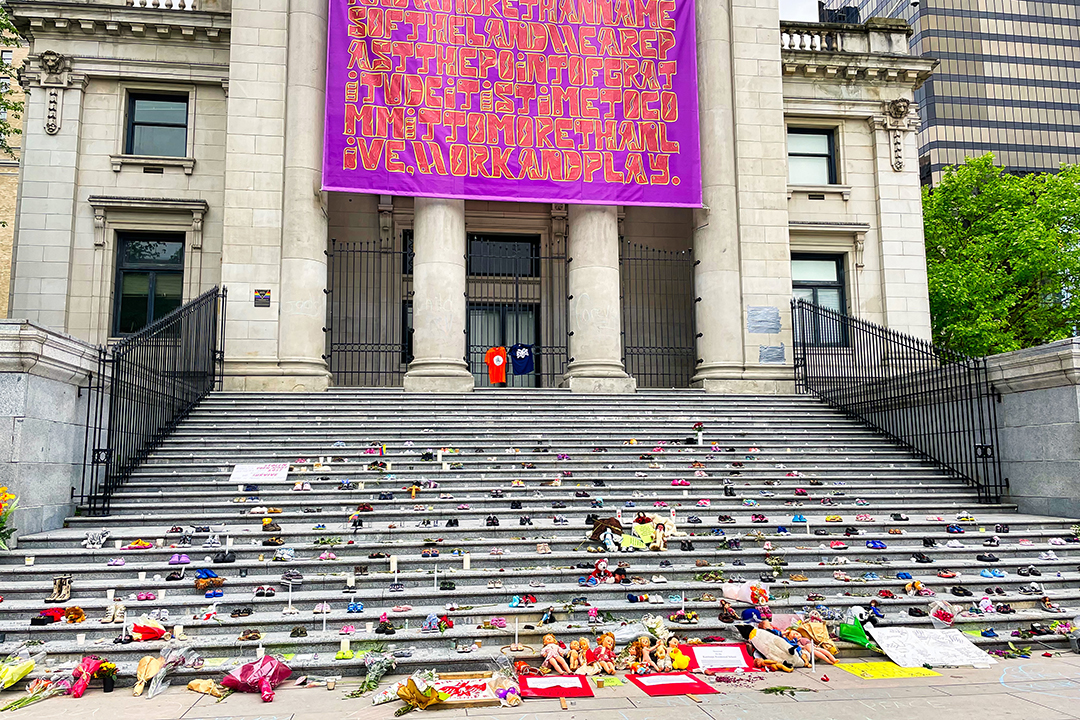Content warning: This article describes abuses committed as a part of the Canadian residential school system.
The recent discoveries of 215 Indigenous children’s bodies on the grounds of the former Kamloops Indian Residential School and 751 unmarked graves in Saskatchewan are unquestionably shocking and heart-wrenching. However, they should come as no surprise if you have been paying attention to the testimonies and stories of residential school survivors.
As survivors have indicated very clearly in conversations and on public records such as the Truth and Reconciliation Commission of Canada (TRC)’s “Missing Children and Unmarked Burials” report, there are children buried in unmarked graves on the grounds of residential schools across Canada. However, despite the overwhelming evidence of systemic abuse, torture, and murder at residential schools under the racist mandate of “[killing] the Indian in the child,” the deaths of Indigenous children have yet to be officially acknowledged as a genocide by the federal government and the international community. Members of the Catholic Church and the Canadian government who carried out these operations have yet to face criminal investigation or charges, either from within Canada or from the International Criminal Court.
The colonial conceptualization of genocide is partially to blame for this failure. In the book Holocaust Memory and Racism in the Postwar World, Dorata Glowacka, a specialist in Holocaust and genocide studies, argues that we need to view genocide outside of the Western lens established in 1948 by the United Nations (UN) Genocide Convention. She explains that the convention avoided the inclusion of colonial genocide in Article III of the convention as a result of opposition by Western states. She continues that Canada, as a colonial settler state, has made distinct efforts to continue its perpetuation of colonialism by preventing the recognition of the genocide of Indigenous peoples in Canada.
So how can we approach justice within Canada’s colonial construct? Our current legal framework does not allow for collaboration between Indigenous and settler governments, but the UN Declaration on the Rights of Indigenous Peoples (UNDRIP) is an international declaration that, if implemented into federal law, could set a crucial precedent to establish Indigenous self-determination in local affairs. Bill C-262, which proposed making the UNDRIP a part of Canada’s federal legislation, failed to pass through the Senate before the 2019 election, but it passed its third reading on June 16.
However, Indigenous sovereignty and self-determination, outlined in Article III of UNDRIP, is still highly contested. British Columbia lawyer and Aboriginal law expert Robert James argued that without the power of sovereignty and self-determination, if UNDRIP is implemented, it will be in the power of the Western courts to interpret.
Moreover, Indigenous leadership is critical when it comes to future investigations as well as political and legal decisions on how to respond to anti-Indigenous crimes. Current consultation processes continue to perpetuate a colonial relationship between Indigenous communities and domestic institutions. Indigenous peoples should not be treated as ‘sidekicks’ in the determination of the path of healing and accountability. This is something that too many high-ranking officials and judiciaries fail to understand and put into practice.
Another area of concern lies within the fact that, despite the TRC’s findings on the inhumane conditions which led to hundreds of wrongful deaths in residential schools, the federal government delayed action to address the experiences of residential school survivors. The indirectness of Prime Minister Justin Trudeau’s recognition of the genocide that occurred because of the creation of residential schools exemplifies how slowly the federal government has acted on the issue. It was only after the discovery of unmarked graves at Kamloops Indian Residential School — six years after the TRC released its findings — that the government began to respond to calls to action, though it has yet to make any core systemic changes.
Instead of responding to these findings and addressing the trauma of residential school survivors, the federal government fought against the Canadian Human Rights Tribunal’s ruling that they should pay $40,000 to each of the 50,000 Indigenous youth who were separated from their communities due to Canada’s deeply dysfunctional child welfare system. A motion was unanimously passed in the House of Commons on June 7 to drop this court fight. However, the motion is not legally binding, and members of the Liberal cabinet — including the prime minister — abstained from the vote. While Trudeau has acknowledged the recent events, the actions of the federal government make its position on Indigenous rights quite clear.
Without recognition, there is no justice for communities plagued by the painful legacy of residential schools. With the federal government’s refusal to respect Indigenous self-determination, the pathway to justice is limited under the constraints of Western legal interpretations. Until Canada has acquired the intellectual capacity to recognize these basic humanitarian principles, the least that can be done in the interim is to commit to respectful and equitable consultation processes.
Shantel Watson is a fourth-year international relations, German, and French student at Trinity College. She served on the Trinity College Board of Stewards in 2019.
If you or someone you know is in distress because of the recent news about residential schools, you can call:
- Indian Residential School Crisis Line at 1-866-925-4419 (available 24 hours a day),
- Hope for Wellness Helpline at 1-855-242-3310,
- KUU-US Crisis Line at 250-723-4050,
- Talk4Healing Help Line at 1-855-554-4325.


